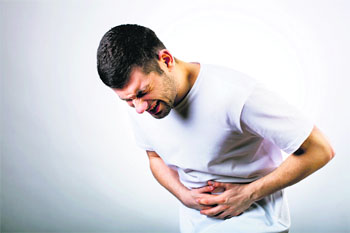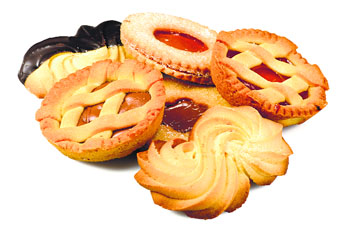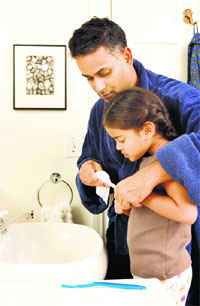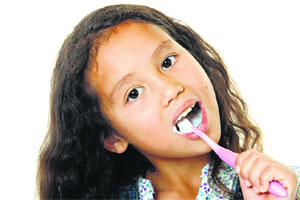|
FITNESS
Gut reaction
Over consumption of junk or refined food can seriously affect our digestive system and cause many stomach disorders
 While
gorging on savoury snacks and business lunches and party dinners
almost everyday, we may forget how food at home tastes. Today, we
equalise everything to the flavour and the taste. Our tongue governs
us and as honest slaves we ensure we fulfil our tongue’s demands!
Funnily enough, this is indeed a fact that none of us realise. As much
importance we devote to the nutritional aspect of food we seem to be
ignoring the number of times we have to attend party buffets and
meeting lunches. The conclusion to this is not differentiating between
nutrition and junk but the disturbed graph of the kind of food we
consume. There is no stability in the composition of food. The ratio
of carbohydrates, proteins and fats and other essential vitamins and
minerals in our diet is seriously disturbed with no consistent diet
plan. While
gorging on savoury snacks and business lunches and party dinners
almost everyday, we may forget how food at home tastes. Today, we
equalise everything to the flavour and the taste. Our tongue governs
us and as honest slaves we ensure we fulfil our tongue’s demands!
Funnily enough, this is indeed a fact that none of us realise. As much
importance we devote to the nutritional aspect of food we seem to be
ignoring the number of times we have to attend party buffets and
meeting lunches. The conclusion to this is not differentiating between
nutrition and junk but the disturbed graph of the kind of food we
consume. There is no stability in the composition of food. The ratio
of carbohydrates, proteins and fats and other essential vitamins and
minerals in our diet is seriously disturbed with no consistent diet
plan.
 There are many disorders
that may arise due to an infected gut and faulty eating practices. There are many disorders
that may arise due to an infected gut and faulty eating practices.
Our body is extremely
systematic and follows a particular pattern to provide an efficient
output. Our digestive tract, out of all other major body systems,
suffers a setback with the poor quality and quantity of food we
consume. Our intestine is home to more than 10,000 types of bacteria.
These bacteria perform specific functions in our body either aiding in
digestion as probiotics or the good bacteria or causing harm to our
digestive tract as bad bacteria resulting in constipation, diarrhoea,
loose motions, acidity, nausea and bloating as consequent symptoms. A
high-fat, sugar-rich or animal protein-based diet results in increased
production of harmful bacteria as opposed to a low-fat, plant-based
diet rich in fibre that leads to the growth of healthy bacteria. To
avoid these symptoms, a healthy ratio of good vs. bad bacteria in our
gut is necessary.
Following is a list of
disorders that could originate as a result of increased bad bacteria
in our gut or as a consequence of intestine reacting to our changing
eating habits.

Clockwise from left: Our digestive tract suffers a setback when we eat poor quality and quantity of food; Fibrous foods like whole grains and multi-grain coarse breads are good for digestion; grains, cereals, nuts, legumes, beans, fruits, vegetables, etc. provide both soluble and insoluble
fibre; and acidic, very spicy and high-fat foods can cause ulcers |
1.Constipation:
This is the most common disorder of the alimentary tract. It relates
to loss of essential muscle tone of our intestinal tract resulting in
infrequent and difficult passage of stools. The muscle tone of our
intestinal tract relies by part on the quality of food we eat. Foods,
high in fibre, would ensure easy passage of smooth stools as opposed
to a high fat and processed or refined food diet. This further leads
to an environment suitable for the survival and growth of bad bacteria
altering the ratio between good bacteria as opposed to the bad.
2.Diverticulitis:
With a history of constipation this is an intestinal disorder most
observed in individuals above 50 years of age. Progressing
constipation due to improper dietary practices leads to complete lack
of muscle tone, hard stools, increase pressure and strain to pass hard
stools, rupturing the intestinal wall forming pocket like structures
called diverticuli, inflammation of which causes severe abdominal pain
with accompanied fever
3.Diarrhoea:
Faulty and unhealthy eating, consumption of acidic, exposed and spicy
foods and overconsumption of drugs to relieve constipation are a few
reasons for continuing loose motions and consequent diarrhoea.
Diarrhoea is an inflammatory state and results in increased losses of
fluids and electrolytes with overgrowth of bad bacteria causing
abdominal cramps and gas formation. Proper nutritional therapy is a
must to minimise the symptoms and reverse the condition.
4.Irritable
bowel syndrome(IBS): IBS involves a disordered pattern of faecal
elimination. There are erratic episodes of constipation followed by
severe diarrhoea. The cause behind this syndrome is unclear but
abnormal food pattern is surely responsible. It is not a diseased
condition but a result of irregular pattern of defecation because of
faulty lifestyle habits.
5.Inflammatory
bowel disease: This diseased condition relates to the presence of
chronic inflammation of the intestine which could be a result of
consequent symptoms such as diarrhoea, excess consumption refined food
items and low fibre intake. Hence, dietary management is most crucial
in this condition.
6.Peptic
ulcers: This is characterised by erosion of the lining of our
gastro-intestinal tract which comes in contact with the juices that
our stomach secretes as part of normal digestion. Acidic food,
consumption of alcohol in large amounts, smoking and consumption of
very spicy foods, along with psychological factors and stress damage
the lining of the tract leading to ulcer formation.

A high-fat, refined and sugar-rich diet results in increased production of harmful bacteria in the gut |
The many roles that the
bacteria in our gut play are beyond imagination and an altered ratio
of these bacteria can indeed lead to some serious consequences. It is,
therefore, of utmost importance to follow a routine diet plan with
limited alterations to ensure harmony inside our body.
The management of the
above mentioned disorders and to build a healthy bacterial gut depends
on making sensible choice of foods whether at home or outside. Keep a
check on portion size while eating in buffets etc. Salads are often
just an illusion of health. These are often topped with high fat
dressings, cheese, cream, excess salt etc. Develop a can-do approach
and believe that you can have a healthy and enjoyable meal while
eating out. Order for your stomach and not for your taste! Therefore,
please note, that a poor diet is second only to emotional, mental and
physiological health.
The writer is one of the
leading holistic health gurus and has a health portal
www.mickeymehtahbf.com
|
Brushing away tooth troubles
The right-type and the right-size brush and a proper cleaning technique can keep a host of dental problems at bay
Dr Simrat Nikhil Bansal
As
soon as we know it’s a tooth hurting; we start brushing a
little more religiously and diligently to cure the ailment.
Little do we realise that although, one of the best preventive
techniques, brushing can do a little to treat the already
existing dental disease. Any dental ailment — be it dental
caries or periodontal disease; becomes an ecological niche in
itself that provides an ideal environment for bacteria to
perpetuate and flourish until intervened by a health
professional. So while prevention is better than cure, effective
prevention requires effective brushing.

Don’t rinse immediately after brushing as this will wash away the fluoride |
For most of us
brushing implies to scrubbing teeth with brush and paste which
may not be as effective as what a good technique can do
Toothbrush tips
Choice of tooth
brush: It is extremely
important to choose right-size of tooth brush. Choosing a brush
which is too small may lead to ineffective coverage of all
dental surfaces while cleaning. Where as a brush that is too big
in size may traumatise the adjacent tissues and make the
cleaning process difficult. While picking your brush, pay
attention to bristle stiffness also –usually labelled as soft,
medium and hard. Soft bristles to not remove the plaque as
effectively but are gentle to the tissues so they are
recommended only in people who have roots exposed due to
periodontal problems. Hard bristles may abrade the tooth
surfaces or lacerate the gum tissues doing more harm than good.
Thus medium-stiff brush is mostly recommended which provides a
good blend of cleansing with protection of hard and soft
tissues.
Method of
brushing: Horizontally
scrubbing your teeth with brush along the gum line can lead to
abrasions on hard tissues like enamel. Bristles should be aimed
at the gum line at a specific angulation of 45 degrees and moved
back and forth in short strokes. Avoid too much pressure while
brushing as it may abrade away the enamel. It is also very
important to reach every corner of the oral cavity while
cleaning. Starting at the same place each time can lead to
certain areas been cleaned and certain being ignored as we reach
towards the end of cleansing cycle. Hence brushing for an
appropriate duration is important . On an average it takes 3-5
minutes to complete the cycle. Special attention should be paid
to inner surfaces of the teeth.
Duration of
brushing: The
recommended 3-5minute time is also the time required for the
fluoride to be released from the tooth paste and taken up by the
teeth. Fluoride is an important element that provides teeth
resistance against dental caries.

The time recommended for brushing is 3 to 5 minutes. This much time is also required for the fluoride to be released from the tooth paste and taken up by the teeth |
Toothbrush
storage instructions:
The common practice of placing a cap on your tooth brush after
is actually more detrimental. Moist environment favours
bacterial growth and reproduction. Toothbrushes should be stored
in an environment where they can dry after use. Six is the magic
number of feet away from the toilet you should store your tooth
brush in order to avoid air-borne particles from toilet making
their way to your bristles. The older Indian custom of having
separate brushing spaces and toilets was indeed more hygiene
friendly compared to our modern-day bathrooms.
Change your
tooth brushes in time:
Ideally tooth brushes should be changed every three months.
Prolonged use of tooth brushes leads to matted and splayed
bristles. Worn-out bristles provide a greater surface area for
bacteria to breed thus facilitating greater transmission of
bacteria.
Brush twice
daily for good oral health:
After breakfast and before going to bed for 3-5 minutes. Use
floss for cleaning tight inter-dental contacts. Don’t rinse
immediately after brushing as this will wash away the fluoride
which we want to linger around the teeth to keep them strong.
Allow a minimum contact of 5-7 minutes between the tooth paste
and teeth so that the beneficial fluoride can be deposited on
teeth. Hold on after eating or drinking sweet or acidic, wait
before you brush. It may seem counter intuitive, but do not
brush your teeth for around 30 minutes. Instead rinse your mouth
with water, milk or mouthwash. Waiting for this time will allow
the harmful acid levels to reduce, so that you are less likely
to damage enamel by brushing. Clean your tongue and soft tissues
as a part of your oral hygiene routine, as bad bacteria can
gather here.
— The writer is
a Ludhiana-based Paediatric dentist |
|